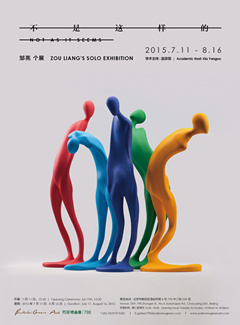时隔四年,邹亮又有新的个展。四年过去了,他的作品有延续也有不同。 延续的是,他依然以个人化的经验,用雕塑或者装置的语言形式,真实生动地去呈现自己在某个具体时空中、对某个具体问题思考时的情绪和状态。创作对他来说不仅是对感受性记忆的再现和收集,也是一种重新思考的过程。执拗的性格使得他无法迅速地从一个问题转向另一个问题,这也才使得他能用一种沉浸的状态去创作,一点一点地将自己的人生感受和经验凝练出来。在这样一个信息过载和频追新番的时代,他的创作却体现了一种“慢”的性格——艺术对于他来说,并没有过多世俗的、快速的工具性和功能性,相反,艺术在他这里回归到更本质的层面——艺术作为语言,真真切切去表达艺术家想说的东西。 作为作者之外的观众,我们对作品的观看更多是把它们放到更大的参照系中来判断,而在邹亮的作品中,创作之初是没有外界参照系的,他和作品之间的关系也非常简单,主体和主体想说的话。维特根斯坦说,没有私人语言,一切都可以是公共的。展示即是将私人语言公开化的过程,艺术家在创作上的努力和对人生的切肤思考也将成为观众共鸣的基础。 与之前看似一个人的独白不同,新作中的人物形象不再是艺术家一个人,而是处于对话中的“我”和“他者”,呈现了一种分析式的社会化视角。新作中艺术家加入了较多的理性思考,把自己和世界的微妙关系放在创作舞台的中心进行审视、思考。这种理性,表现在艺术家更加审慎地期望通过合适的、多样化的雕塑语言和手法,比如雕塑的色彩、材料、造型等去表达自己直觉式的思考,也表现在他对处于相互关系中的人或物的辩证态度,比如《兄弟》、《彼此》《思过》等作品,从一种结构性的场域中去呈现关系的非单一视角,将动态的东西静态化,让日常生活中容易被忽略的东西再次被聚焦,使之处于一种可变换位置的关系中,原有的、经验意义上的关系被结构的同时也被有意无意地解构了,体现了人与人、世界之间的关系的脆弱性和不确定性。
Zou Liang is presenting us a new solo. The works to be presentedthis time are related to those at the previous one four years ago as continuation, as well as diversion. On one hand, he continues to draw on his personal experience and capture by means of a sculpture or an installation, in a real and vivid way, his mood and state of mind while he is thinking about a specific question in a specific place at a specific time. In this case, he believes, art production is not only a representation and collection of his receptive memory but a process of rethinking. The stubbornness in his character makes it difficult to shift rapidly from one question to another, therefore enabling him to immerse himself in art production and to distill his reflections about life and his experience. In an age marked with an excess of information and updated entertainment programs, his works, however, show some quality of being “slow”. In other words, art, in his understanding, should be far from vulgar and functional, and rather, it should return to the essence, that is, art, as language, as a means of expression, has to express authentically what an artist really wantsto say. As audience, we tend to give our judgment about a work of art in a broader frame of reference, but in Zou’s work, there is no frame of reference in the beginning, and as an artist, he is related to the work in a very simple way: it is all about a dialogue between two subjects. According to Wittgenstein, no language is private, and everything can be public. To display means making a private language public. In this sense, an artist’s effort in creation and his profound thinking make up the basis of empathy from the audience. By contrast to his previous works that seemed to be a monologue, these new works involve no longer the artist alone, but “I” and“other” in a dialogue, showing an analytical social perspective.There is more rational thinking on the part of the artist, who now focuses on his subtle relation with the world in his reflection and consideration. Such rationality finds expression in the artist’s cautious effort to express his intuitive thinking by means of appropriate and diversified sculptural discourse and techniques, like color, material and modeling, as well as in his dialecticalunderstanding of the relation between everything involved, as is shown in “Brothers”, “Each other”, “Reflecting”, etc. These works reveal a non-monotonic perspective in presenting the relations in a structural context, so not only the dynamic becomes static, but also what is easily overlooked in everyday life is refocused on and placed in a relational context based on the changeable relation. The previous relation based on experience is not only structuralized but also deconstructed wittingly or unwittingly, highlighting the fragility and indefiniteness of the relation between human beings themselves and their relation to the world.

